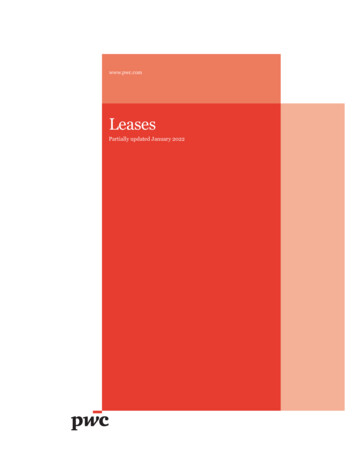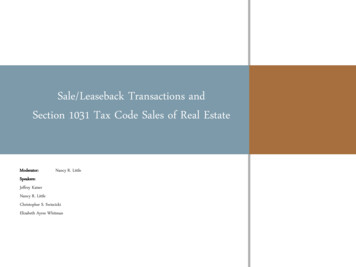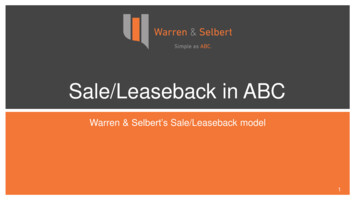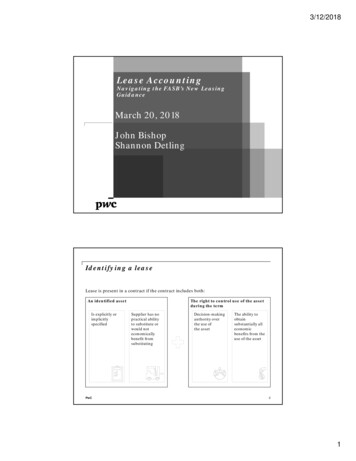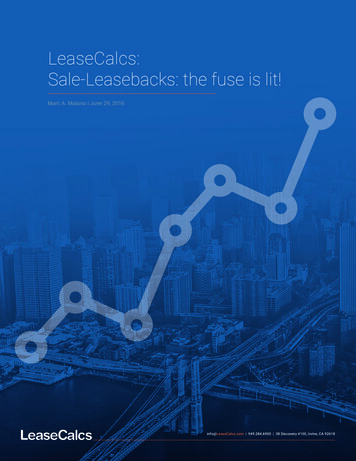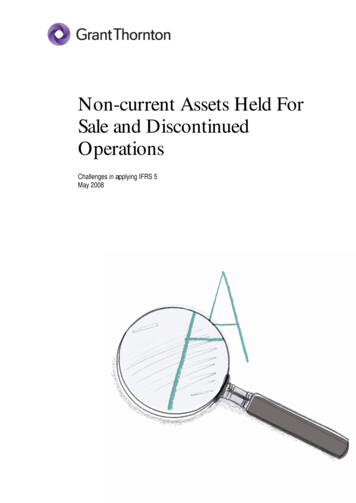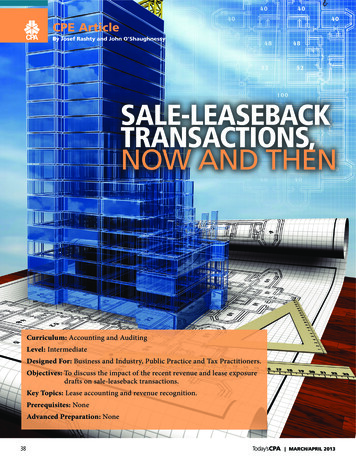
Transcription
CPE ArticleBy Josef Rashty and John O’ShaughnessySALE-LEASEBACKTRANSACTIONS,NOW AND THENCurriculum: Accounting and AuditingLevel: IntermediateDesigned For: Business and Industry, Public Practice and Tax Practitioners.Objectives: To discuss the impact of the recent revenue and lease exposuredrafts on sale-leaseback transactions.Key Topics: Lease accounting and revenue recognition.Prerequisites: NoneAdvanced Preparation: None38Today’sCPA MARCH/APRIL 2013
Companies use sale-leaseback transactions tounlock the equity that they have in their assets,such as machinery and equipment, and convert itto cash. They accomplish this by conveying the titleof their assets at fair value to a third party (usuallya financial institution) in exchange for lump-sumcash payments. The third party then leases backthe assets to the company. However, there areproposed changes to the current accounting forsale-leaseback transactions, which may limit someof its financial advantages.In August 2010, the Financial Accounting Standards Board (FASB)and the International Accounting Standards Board (IASB) jointlyreleased an exposure draft (ED), Leases, and proposed an accountingmodel that would significantly change lease accounting. One ofthe objectives of this ED is to ensure assets and liabilities arisingfrom leasing transactions are reflected on the company’s statementof financial position. The subsequent comment period producedsignificant concern about the complexity of the guidance. As such,the two Boards announced in July of 2011 they would re-expose theproposed leasing standard in 2012 and issue the final standard by late2013.The Boards also jointly issued another ED in June 2010, Revenuefrom Contracts with Customers, to supersede virtually all existingrevenue guidance under U.S. Generally Accepted AccountingPrinciples (GAAP) and International Financial Reporting Standards(IFRS). The comment period for this ED ended in October 2010. TheBoards decided to re-expose their revenue proposal in November2011 subsequent to deliberations. The comment period for the revisedED was 120 days and ended on March 13, 2012. The Boards plan tocontinue their re-deliberations and outreach on the revised revenuerecognition ED and issue the final standard by mid-2013.The proposed lease and revenue guidance have importantbusiness implications for sale-leaseback transactions. The plannedrecognition of significantly more assets and liabilities along withrelated amortization and interest expense in financial statementswould impact the contract negotiations, financial ratios, and businesssystems for public and private entities. The objective of this article isto analyze the impact of the lease and revenue EDs on sale-leasebacktransactions.SALE-LEASEBACK TRANSACTIONSA sale-leaseback transaction involves the sale of an asset and leaseback of the same asset by a seller/lessee. In a typical sale-leasebackToday’sCPA MARCH/APRIL 2013transaction, the seller sells an asset to the purchaser, yet retains theright for a long-term continued use of the asset through a leasingarrangement. Essentially, the transaction is arranged so that thepurchaser/lessor relinquishes control over the asset through a leasing arrangement, which gives the seller/lessee the same control andresponsibility over the asset. The seller/lessee retains a future interestin the asset (generally through options to purchase), so that after acertain time period, the seller/lessee may repurchase the asset.Under such an arrangement, the seller/lessee secures capital, whileretaining use of the asset, and the purchaser/lessor, as owner, mayreceive tax benefits such as depreciation deductions and interestdeductions arising from loan indebtedness. The seller/lessee maytake deductions on rental payments. The benefits of these deductionsgenerally outweigh the loss of tax benefits related to depreciationdeductions that the seller/lessee foregoes by relinquishing ownershipof property.The rental payments made by the seller/lessee over the course ofthe lease term typically match the purchaser/lessor’s principal plusinterest on the loan for the property. The purchaser/lessor typicallyretains a reversionary interest, subject to future options to purchase,or extensive lease renewal options by the seller/lessee.Entities, such as airline and real estate companies, have traditionallyentered into sale-leaseback transactions for a variety of reasons andpurposes, including the following:r alternative financing,r tax considerations,r strengthening the balance sheet.Alternative FinancingSale-leaseback transactions can provide a source of financing andliquidity. For example, Southwest Airlines raised 381 million fromsale-leaseback transactions during 2009, greatly contributing to its2009 ending cash balance of 1.1 billion. 2512049647/d293991d10k.htm)Sale-leaseback transactions can provide more funds than acomparable loan using the same asset as collateral since it allows theseller/lessee to raise cash for the full value of the asset, whereas thecollateralized loan allows the entity to raise funds typically less than100 percent of the asset’s value.Tax ConsiderationsSale-leaseback transactions have several tax advantages for thelessees compared to collateralized loans discussed in the previousparagraph. For example, lease payments are fully deductible in saleleaseback transactions, whereas only the interest portion of theircollateralized loan payments may be deducted.Sale-leaseback transactions can create capital gains and losses forthe seller/lessee, which potentially diminish the impact of unexpectedtax situations. For example, during the recent financial crisis, manycontinued on next page39
CPE Articlecontinued from page 39For example, Southwest Airlines leases a good portion of itsassets, some of which are the results of sale-leaseback transactions.The majority of Southwest’s terminal operations space, as well asmany of its aircrafts, were classified as operating leases as of Dec.31, 2011. Total rental expenses for operating leases in 2011 and 2010were 847 million and 631 million, respectively. Future operatingrent expense commitments were 5,583 million at the end of fiscalyear 2011, while current liabilities and long-term debt net of currentportion at the end of the fiscal year 2011 were 4,533 million and 3,107 million, respectively. 19312512049647/d293991d10k.htm)THE CURRENT U.S. GAAP GUIDANCE ANDSALE-LEASEBACK TRANSACTIONScompanies accumulated significant capital losses, potentially offsettingcapital gains created by sale-leaseback transactions.If seller/lessees cannot take full advantage of accelerateddepreciation, they may structure a deal with a third-party leasingcompany to sell their assets and lease them back. Both seller/lessee andpurchaser/lessor may benefit from such transaction. The purchaser/lessor can possibly pass the benefits that it receives from acceleratedand bonus depreciation, and Section 179 expensing to the seller/lessee through lower lease payments, while seller/lessee may benefit bypossibly receiving capital gains and securing alternative financing.Structuring a genuine sale-leaseback transaction amenable for taxpurposes requires careful planning. Historically, the Internal RevenueService (IRS) has considered sale-leaseback transactions as “sham”transactions, lacking any economical substance and thus void for taxpurposes.Some companies have used crafty financial maneuvering to makerisk for both parties nonexistent. For example, the purchaser/lessorwould take out a loan from a third party and use the loan proceeds topay for the purchase of the assets. The seller/lessee, on the other hand,uses those proceeds to make rent payments for the use of its soldassets. The purchaser/lessor uses those rent payments to pay back itsloan, rendering the financial arrangement almost entirely circular andoff-setting. The IRS may question such sale-leaseback transactions onthe grounds that the true ownership does not reside with purchaser/lessor, particularly where the seller/lessee is obligated to pay forimprovements and maintenance, property taxes, and insurance (only atrue owner normally undertakes such responsibilities).Strengthening the Balance SheetA few years ago, the Securities and Exchange Commission (SEC)estimated the undiscounted amount of off-balance-sheet leaseobligations at approximately 1.25 trillion pdf). One of the advantages for the seller/lessee in a sale-leaseback transaction under the current guidance is thepossibility that the lease may be recognized as an operating lease withoff-balance-sheet liabilities. Solvency metrics such as the current ratio,as well as other metrics such as debt to equity, return on equity, andinterest coverage, are all affected positively with such an accountingtreatment.40Under the current guidance in a lease arrangement, the lesseecan potentially account for leases either as operating or capitalleases depending on certain circumstances. In an operating lease,the lessee reflects the lease rentals in the statement of operationson a straight-line basis. In a capital lease, on the other hand, thelessee measures the liability based on the estimated lease termat the present value of the estimated future lease payments,discounted using the lessee’s incremental borrowing rate or, if itcannot be readily determined, the rate the lessor charges the lessee.This provision is available to a seller/lessee in a sale-leasebackarrangement.The current guidance treats a sale-leaseback arrangement asa financing transaction in which any profit or loss on the saleis deferred and amortized by the seller/lessee. The seller/lesseeamortizes the deferred profits and losses over the lease term or theleased items’ economic life for capital leases; for operating leases, theseller/lesser amortizes deferred profits and losses in proportion tothe rental payments over the period of asset use.An exception to deferring the profit and loss occurs whenthe seller/lessee relinquishes the right to substantially all of theremaining use of the property sold. In that case, the sale and theleaseback shall be accounted for as separate transactions, and thelessee recognizes gains and losses immediately.The sale-leaseback rules do not impact the purchaser/lessor’saccounting. A purchaser/lessor involved in a sale-leasebacktransaction usually accounts for the transaction as the acquisition ofan asset and either a corresponding financing or operating lease out.THE PROPOSED GUIDANCE ANDSALE-LEASEBACK TRANSACTIONSUnder the current guidance, sale-leaseback transactions canresult in off-balance-sheet liabilities for the seller-lessee when asale is recognized and the lease is classified as an operating lease.The lease ED, on the other hand, proposes that sale-leasebacktransactions would no longer be off-balance sheet since lesseeswould be required to recognize all leases in their balance sheets(Rashty and O’Shaughnessy, “The Ever-Changing Lease ExposureDraft,” Today’s CPA, November/December 2011). Sale-leasebacktransactions may also be affected by the Revenue from Contractswith Customers ED re-exposed in November 2011.Today’sCPA MARCH/APRIL 2013
TABLE 1.1Call options (IG40)Seller/lessee has an unconditional right torepurchase the leased assetIf the repurchase price is equal or higher than original selling price, thetransaction is a financing arrangement.If the repurchase price is less than original selling price, the transaction iswithin the scope of Lease guidance.2Forward rights (IG40)Seller/lessee has an unconditionalobligation to repurchase the leased assetIf the repurchase price is equal or higher than original selling price, thetransaction is a financing arrangement.If the repurchase price is less than original selling price, the transaction iswithin the scope of Lease guidance.3Put options – therepurchase price is equalor higher than originalselling pricePurchaser/lessor has an unconditional right If the repurchase price is equal or greater than expected market value of theto require the seller/lessee to repurchaseasset, the transaction is a financing arrangement (IG46).the assetIf the purchaser/lessor does not have significant economic incentives toexercise the put option, then transaction is a sale with a right of return andwithin the scope of Revenue Recognition guidance (IG45).4Put options – therepurchase price is lessthan original sellingpricePurchaser/lessor has an unconditional right If the purchaser/lessor has a significant economic incentive to exercise theto require the seller/lessee to repurchaseput option, the transaction is within the scope of Lease guidance (IG43).the assetIf the purchaser/lessor does not have significant economic incentive toexercise the put option, the transaction is a sale with a right of return and iswithin the scope of Revenue Recognition guidance (IG45).The Boards have tentatively decided that a seller/lessee would nowapply the guidance in the revenue recognition standard to determinewhether to recognize a sale of the underlying asset. If the revenuerecognition standard’s requirements for sale accounting are met, thetransaction would be accounted for as a sale and leaseback of theunderlying asset; otherwise, the transaction would be accounted foras a financing of the underlying asset, requiring the asset to remain onthe seller/lessee’s balance sheet.Generally, a sale-leaseback transaction that does not qualify as asale would be accounted for as a financing of the underlying asset. Asale-leaseback transaction that is accounted for as a sale and leasebackwould result in de-recognition of the underlying asset by the seller/lessee and recognition of a gain or loss for the difference between theconsideration received from the purchaser/lessor and the carryingvalue of the underlying asset.The amount of the gain or loss would be adjusted to reflect currentmarket rates for the lease of the underlying asset if the transactionprice is not at market price. If the transaction qualifies as a sale, again or loss would be recognized immediately. The Boards have alsoproposed that if the sale or leaseback is not established at fair value,the asset, liability and gain or loss would be adjusted to reflect currentmarket rentals. The seller/lessee would recognize a right-of-useasset and a lease liability for the leaseback of the underlying asset intransactions that qualify as sales.The proposed guidance treats short-term leases (leases of 12months or less) similar to operating leases under the existingguidance. Table 1 summarizes the impact of the repurchase provisionin sale-leaseback transactions under the Revenue Recognition EDparagraphs IG38-IG48.LATEST DEVELOPMENTSIn June 2012, the Boards announced that they support a principlefor classifying leases based on whether the lessee acquires andToday’sCPA MARCH/APRIL 2013consumes more than an insignificant portion of the underlying assetover the lease term. Based on that decision, leases would be classifiedas either leases of property (i.e., land, building or part of a building),recognized as straight-line leases, or leases of assets other thanproperty (e.g., equipment), recognized as accelerated leases.Lessors would apply operating lease accounting to straight-lineleases and the Receivable & Residual (R&R) approach to acceleratedleases (Rashty and O’Shaughnessy, “The Ever-Changing LeaseExposure Draft, Part II – Lessor Accounting,” Today’s CPA, May/June 2012). Lessors following operating lease accounting wouldneither recognize a lease receivable nor derecognize a portion of theunderlying asset even though the lessee would recognize a liability forfuture lease payments and a corresponding right-of-use asset.ILLUSTRATIONEntity S (the seller/lessee) sells equipment with a fair marketvalue and book value of 37,000 to Entity P (the purchaser/lessor).Assume that fair market value is equal to book value to simplify theillustration.Entity P enters into a three-year lease agreement with Entity S.The carrying value (CV) of the equipment is 37,000, which isequal to its fair market value (FV) at the commencement of thelease, and the equipment is estimated to have a residual value of 5,000 at the end of the three-year lease. The total lease receivable(LR) at the commencement of the lease was 32,832. Entity S has anunconditional right to repurchase the equipment (a call option) at 5,000 and exercises this option at the end of the lease term. Assumethat residual value is equal to fair market value to simplify theillustration.Entity P charges Entity S a monthly lease payment of 1,000 inarrears, which is equal to 6.08 percent return (the implicit rate inthe lease agreement). The lease receivable for 32,832 is equal to thecontinued on next page41
CPE Articlecontinued from page 42EXHIBIT IReceivable and Residual Approach – Sale/Leaseback – Purchaser/Lessor’s PerspectiveJournal Entries:YearCash0( 37,000) (a)0 - 32,832 (d) 4,168 (f)1 12,000 (b)( 10,287) (e) 261 (g)( 1,713) (i)( 261) (g)2 12,000 (b)( 10,931) (e) 277 (g)( 1,069) (i)( 277) (g)3 12,000 (b)( 11,614) (e) 294 (g)( 386) (i)( 294) (g)3 5,000 (c)a.b.c.d.e.Lease Receivable Residual AssetUnderlying Asset Lease RevenueInterest Income 37,000 (a)( 37,000) (h) -( 5,000) (c)Purchase of equipment from lessee for 37,000.Annualized monthly lease payments of 1,000.Sale of equipment to lessee for 5,000 at the end of the lease dueto lessee’s exercise of call option.Lease receivable is equal to the present value of an ordinary annuityof 1,000 discounted at 6.08 percent over 36 months.Collection of lease receivable amortized using the effective methodat 6.08 percent.f.g.h.i.Residual asset represents the rights to the underlying asset retainedby the lessor and is equal to CV – (CV X (LR/FV)) or 37,000 –( 37,000 X ( 32,832/ 37,000)) 4,168.The residual asset is accreted using 6.08 percent interest rate toarrive at 5,000 residual value at the end of the lease.De-recognition of asset due to leaseback.The lease revenue on the lease receivable, which is amortized usingthe effective method at 6.08 percent.EXHIBIT IIReceivable and Residual Approach – Sale/Leaseback – Seller/Lessee’s PerspectiveJournal Entries:YearCash0 37,000 (a)0Right to Use AssetsUnderlying AssetLiabilitiesAmortization ExpenseInterest Expense( 37,000) (a) 32,832 (d)( 32,832) (d)1( 12,000) (b)( 10,944) (e) 10,287 (f) 10,944 (e) 1,713 (g)2( 12,000) (b)( 10,944) (e) 10,931 (f) 10,944 (e) 1,069 (g)3( 12,000) (b)( 10,944) (e) 11,614 (f) 10,944 (e) 386 (g)3( 5,000) (c)a.b.c.d. 5,000 (c)Sale of equipment from lessee for 37,000.Annualized monthly lease payments of 1,000.Purchase of equipment from lessor for 5,000 at the end of thelease due to lessee’s exercise of call option.Right to use assets and liabilities are equal to the present value ofan ordinary annuity of 1,000 discounted at 6.08 percent over 36months.present value of the lease payments discounted at 6.08 percent. TheExhibits I and II reflect the journal entries in purchaser/lessor andseller/lessee books.POSSIBLE DETERRENTThe new guidance would undoubtedly impact the structureand most likely the number of future sale-leaseback transactions.e.f.g.Amortization of the right to use assets.Lease payments less applicable interest.Applicable interest at 6.08 percent.The proposed guidance that sale-leaseback transactions no longerbe considered off-balance-sheet items may serve as a deterrent tocompanies’ decisions to engage in such transactions. Nevertheless,sale-leaseback transactions will continue to appeal to many companies,in one form or the other, as an alternative source of financing withpotential tax advantages. Josef Rashty, CPA, has held managerial positions with several publicly held technology companies in the Silicon Valley region ofCalifornia. He is a member of the Texas Society of CPAs and can be reached at jrashty@sfsu.edu. John O’Shaughnessy, Ph.D., CPA(inactive), is an accounting professor at San Francisco State University. He can be reached at joshaun@sfsu.edu.42Today’sCPA MARCH/APRIL 2013
CPE QuizToday’s CPA offers the self-study exam belowfor readers to earn one hour of continuingprofessional education credit. The questionsare based on technical information from thepreceding article. Mail the completed test byApril 30, 2013, to TSCPA for grading.If you score 70 or better, you will receivea certificate verifying you have earned onehour of CPE credit – granted as of the datethe test arrived in the TSCPA office – inaccordance with the rules of the Texas StateBoard of Public Accountancy (TSBPA). If youscore below 70, you will receive a letter withyour grade. The answers for this exam willbe posted in the next issue of Today’s CPA.Answers to last issue’s self-study exam:1. C 2. D 3. B 4. D 5. A 6. B 7. B 8. D 9. C 10. BPARTICIPATION EVALUATION(Please check one.) 5 excellent 4 good3 average2 below average 1 poor1. The authors’ knowledge of the subject is:5 4 3 2 1 .2. The comprehensiveness of the article is:5 4 3 2 1 .3. The article and exam were well suited to mybackground, education and experience:5 4 3 2 1 .4. My overall rating of this self-study exam is:5 4 3 2 1 .5. It took me hours and minutes to studythe article and take the exam.NameCompany/FirmAddress (Where certificate should be mailed)City/State/ZIPEnclosed is my check for: 10(TSCPA member) 20 (non-member)Please make checks payable toThe Texas Society of CPAs.SignatureTSCPA Membership No.After completing the exam, please mail this page(photocopies accepted) along with your checkto: Today’s CPA; Self-Study Exam: TSCPA CPEFoundation Inc.; 14651 Dallas Parkway, Suite700; Dallas, Texas 75254-7408. TSBPA RegisteredSponsor #260.Today’sCPA MARCH/APRILJANUARY/FEBUARYNOVEMBER/DECEMBER2013 20132012Sale-Leaseback Transactions, Now and ThenBY JOSEF RASHTY AND JOHN O’SHAUGHNESSY1 In a typical sale-leaseback transaction,the seller sells an asset to the purchaser,yet retains the right for a long-termcontinued use of the asset through aleasing arrangement.A. TrueB. False2 Companies enter into sale-leasebacktransactions for which of the followingreasons:A. Alternative financingB. Tax considerationC. Strengthening the balance sheetD. All of the above3 When compared to a comparablecollateralized loan, sale-leasebacktransactions can provide more fundsbecause the sale-leaseback allows theseller/lessee to raise cash for the fullvalue of the asset.A. TrueB. False4 Sale-leaseback transactions providelessees with certain tax advantages suchas:7 Under the proposed guidance, aseller/lessee would now apply revenuerecognition standards to determinewhether to recognize a sale of theunderlying asset. If the sales recognitionstandards are met:A. The transaction could be accounted for as a saleand leaseback of the underlying asset.B. The seller/lessee would de-recognize the underlyingasset.C. The seller/lessee would recognize a gain or lossimmediately.D. All of the above.8 When a seller/lessee has anunconditional right to repurchase theleased asset, this is considered a:A. Call option.B. Forward rightsC. Put optionD. None of the above9 In the latest developments (June2012), the Boards announced that theysupport a principle for classifying leasesbased on whether the lessee acquiresand consumes more than an insignificantportion of the underlying asset over thelease term. As such, the Boards wouldsupport classifications for leases as eitherstraight-line or accelerated dependingupon the type of property.A. Lease payments are fully deductible in saleleaseback transactions.B. Sale-leaseback transactions can create capital gainsand losses.A. TrueC. Both of the above.B. FalseD. None of the above.5Under existing GAAP, theseller/lessee amortizes deferredprofits and losses:A. for capital leases over the lease term or the leaseditems’ economic life.B. for capital leases in proportion to the rentalpayments over the period of asset use.C. for operating leases over the lease term or theleased items’ economic life.D. None of the above.10 As illustrated in Exhibit II of theillustration, the total effect on the seller/lessee’s first year’s expenses come fromthe following source/s:A. Amortization of the right-of-use assetB. Interest on the lease liability and amortization ofthe right-of-use assetC. Lease paymentsD. Interest on the lease liability6 Under existing GAAP, sale-leasebacktransactions can result in off-balancesheet liabilities for the seller-lessee whenthe lease is classified as an operatinglease. However, the lease ED wouldrequire that lessee recognize all leases ontheir balance sheets.A. TrueB. False43
For example, Southwest Airlines raised 381 million from sale-leaseback transactions during 2009, greatly contributing to its . proposed changes to the current accounting for sale-leaseback transactions, which may limit some of its financial advantages. continued on next page. 40 Today's CPA MARCH/APRIL 2013
